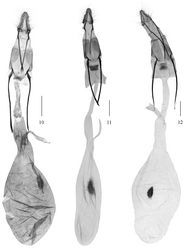Ectomyelois furvivena
| Notice: | This page is derived from the original publication listed below, whose author(s) should always be credited. Further contributors may edit and improve the content of this page and, consequently, need to be credited as well (see page history). Any assessment of factual correctness requires a careful review of the original article as well as of subsequent contributions.
If you are uncertain whether your planned contribution is correct or not, we suggest that you use the associated discussion page instead of editing the page directly. This page should be cited as follows (rationale):
Citation formats to copy and paste
BibTeX: @article{Ren2016ZooKeys, RIS/ Endnote: TY - JOUR Wikipedia/ Citizendium: <ref name="Ren2016ZooKeys">{{Citation See also the citation download page at the journal. |
Ordo: Lepidoptera
Familia: Pyralidae
Genus: Ectomyelois
Name
Ectomyelois furvivena Ren & Yang, 2016 sp. n. – Wikispecies link – ZooBank link – Pensoft Profile
Type material
Holotype ♂, CHINA: Rare Botanical Garden, Ruili (24°00'N, 97°50'E), Yunnan, 1000 m, 8-VII-2005, leg. Yingdang Ren, gen. slide no. RYD04737. Paratypes: Gansu: 1 ♂, Fanba (32°44'N, 105°07'E), Wenxian, 718 m, 18-VII-2005, coll. Haili Yu, gen. slide no. RYD04744. Yunnan: 2 ♂♂, same data as for holotype, gen. slide nos. LHX14084, LHX14084w, LHX14085; 1 ♀, Botanical Garden, Menglun (21°52'N, 101°18'E), 570 m, 13-VIII-2005, coll. Yingdang Ren, gen. slide no. RYD04720; 1 ♂, Baihualing, Mt. Gaoligong (25°31'N, 98°32'E), 1470 m, 30-VII-2013, coll. Linlin Yang, gen. slide no. RYD20120181 (deposited in HAASM).
Diagnosis
This new species is similar to Ectomyelois bipectinalis sp. n., but can be recognized by the male antenna is not bipectinate, the uncus is rather abruptly narrowed beyond its broad base, tapered apical projection of the gnathos is about half length of the uncus and the inverse-goblet transtilla in the male genitaia. In Ectomyelois bipectinalis sp. n., the antenna is bipectinate, the uncus protrudes triangularly at basal 2/5, the apical projection of gnathos is about 3/5 length of the uncus and the transtilla is trefoiled in the male genitalia. There is little difference in the female genitalia except the corpus bursae is much broader and the signum is smaller than in Ectomyelois bipectinalis sp. n.
Description
Wingspan 25.0−30.0 mm (Figs 5, 6). Vertex brown, with individual scales grayish white-tipped. Antenna (Fig. 5a, b) brown, scales dark-tipped. Labial palpus brown, first segment with scales grayish white-tipped. Maxillary palpus brown. Occiput, patagium, tegula and thorax grayish brown, with scales tipped with grayish white. Forewing dark grayish brown with some white powdering, black along veins; antemedial line invisible; discal spots blackish brown, separated; postmedial line faint, grayish white, serrated, gently curved inwardly from costal 1/5 to dorsum 1/5; terminal line black, interrupted; cilia brown. Hindwing grayish white, light brown along costa and veins; cilia white. Foreleg blackish brown; mid- and hind legs brown with grayish white powdering, spurs yellowish brown. Abdomen with each tergite gray basally and grayish white distally, sternite yellowish brown.
Male genitalia (Fig. 9). Uncus bell-shaped, length longer than wide, abruptly narrowed beyond its broad base, rounded at apex. Apical projection of gnathos about half length of uncus, tapered, slightly bent and furcated at apex. Transtilla inverse-goblet shaped; deeply concaved in U shape on anterior margin, a rounded plate protruding on posterior margin. Valva three times as long as wide, evenly curved toward rounded apex, costal margin almost parallel with ventral margin, ventral margin concave at basal 1/3; costa strongly sclerotized, broad at base, narrowed and extending to near end of valva, without process apically; sacculus strongly sclerotized, stout, 2/5 length of valva. Juxta a broad, quadrate plate; lateral lobes ovate, 1.5 times as long as wide, bearing sparse setae in distal half. Vinculum trapezoid, widest posterior margin about 1.6 times of its length, straight on anterior margin. Phallus about 2/3 length of valva, smooth inside; cornutus absent. Eighth tergite cupped, with a pair of triangular sclerites anteriorly; eighth sternite with a pair of boot-like sclerites narrowly connected anteriorly. Culcita simple, one pair of fine scale tufts.
Female genitalia (Fig. 12). Anal papillae triangular, with a few setae, blunt apically. Eighth tergite slightly concave on posterior margin, convex W-shaped on anterior margin; eighth sternite with membranous part inverse-funneled. Antrum somewhat quadrate. Ductus bursae membranous, 1.5 times length of apophyses posteriores. Corpus bursae membranous, about same length as ductus bursae, twice as wide; signum a spindle-like patch of scobinations, at middle of corpus bursae. Ductus seminalis from junction of corpus bursae and ductus bursae.
Distribution
China (Gansu, Yunnan).
Etymology
The specific name is derived from the Latin prefix furv-, meaning black, and the Latin vena, vein, referring to the forewing with black scales along its veins in this species.
Original Description
- Ren, Y; Yang, L; 2016: Ectomyelois Heinrich, 1956 in China, with descriptions of two new species and a key (Lepidoptera, Pyralidae, Phycitinae) ZooKeys, (559): 125-137. doi
Images
|


